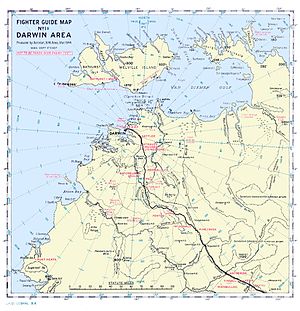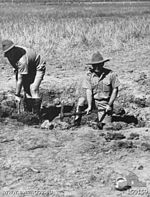
The Bombing of Darwin, also known as the Battle of Darwin, on 19 February 1942 was the largest single attack ever mounted by a foreign power on Australia. On that day, 242 Japanese aircraft, in two separate raids, attacked the town, ships in Darwin Harbour and the town's two airfields in an attempt to prevent the Allies from using them as bases to contest the invasion of Timor and Java during World War II.

The town of Broome, Western Australia, was attacked by Japanese fighter planes on 3 March 1942, during World War II. At least 88 civilians and Allied military personnel were killed.

RAAF Base Townsville is a Royal Australian Air Force (RAAF) air base located in Garbutt, 2 nautical miles west of Townsville in Queensland, Australia. It is the headquarters for No. 1 Wing Australian Air Force Cadets and, along with Lavarack Barracks, establishes Townsville as a key military centre. The base's airfield is shared with the Townsville Airport.
Air traffic control in Australia is provided by two independent organisations, one civilian and one military. The civilian provider is Airservices Australia, which controls civilian airfields and airspace. The military provider is the Royal Australian Air Force (RAAF), which controls military airfields and adjoining airspace. This includes Australian Army and Royal Australian Navy aviation bases.
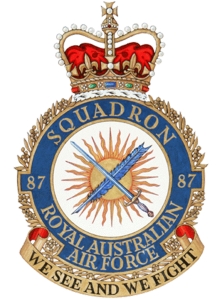
No. 87 Squadron is a Royal Australian Air Force (RAAF) air intelligence squadron. It saw action during World War II as a photo reconnaissance squadron, being raised in September 1944 through the re-designation of No. 1 Photo Reconnaissance Unit, which had been formed in June 1942. Throughout the war, No. 87 Squadron flew a variety of aircraft from bases in Australia, gathering photographic intelligence on Japanese forces and installations throughout the Pacific. At the conclusion of hostilities, the squadron was disbanded but was later re-formed in 1948, carrying out aerial survey operations in Australia until 1953. In 2006, it was re-raised again as a non-flying squadron tasked with air intelligence analysis as part of the Information Warfare Directorate within the RAAF's Air Warfare Centre.

No. 13 Squadron is a Royal Australian Air Force (RAAF) squadron. The unit saw combat during World War II as a bomber and maritime patrol squadron and is currently active as a mixed regular and reserve RAAF unit located in Darwin, fulfilling both operational support and training duties.
No. 1 Wireless Unit RAAF was an Australian signals intelligence unit of World War II. The Unit was established on 25 April 1942.

Kalumburu and Kalumburu Community are both bounded localities within the Shire of Wyndham-East Kimberley in Western Australia. Kalumburu Community is the northernmost settlement in Western Australia.

No. 457 Squadron was a Royal Australian Air Force (RAAF) fighter squadron of World War II. Equipped with Supermarine Spitfire fighters, it was formed in England during June 1941 under Article XV of the Empire Air Training Scheme. The squadron was transferred to Australia in June 1942 and saw combat in the South West Pacific Area before being disbanded in November 1945.
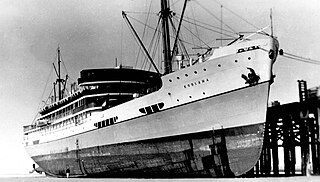
MV Koolama was an Australian merchant vessel that sank as a result of several attacks by Japanese aircraft in February–March 1942. It was also the centre of the Koolama Incident, an alleged mutiny resulting from these attacks.
The Daly Waters Airfield, also RAAF Base Daly Waters, is a former commercial and sporadically-used military airfield located at Daly Waters, Northern Territory, Australia. As an airfield on Australia's earliest international routes, Daly Waters was used throughout the 1920s and 1930s as a stop over for commercial airlines operating on the domestic route to Western Australia and international carriers flying from Australia into south-east Asia via Darwin. During World War II, the airbase was used by the Royal Australian Air Force (RAAF) and the United States Army Air Force to undertake combat operations against the Japanese in New Guinea, the Dutch East Indies and the islands to Australia's north. Following the war, the airbase was used commercially again up until the 1970s when the airfield was sporadically-used by the RAAF.

Fenton Airfield was a World War II military airfield in the Northern Territory of Australia located at Tipperary Station in what is now the locality of Douglas-Daly and named after flight lieutenant Clyde Fenton.
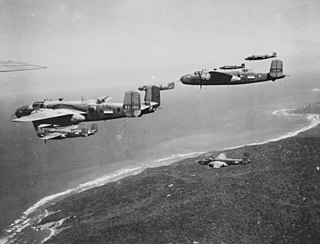
The North-Western Area Campaign was an air campaign fought between the Allied and Japanese air forces over northern Australia and the Netherlands East Indies (NEI) between 1942 and 1945. The campaign began with the Japanese bombing of Darwin on 19 February 1942 and continued until the end of the war.
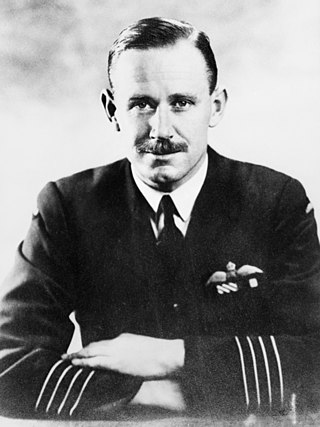
John Margrave Lerew, DFC was an officer and pilot in the Royal Australian Air Force (RAAF) during World War II, and later a senior manager in the International Civil Aviation Organization (ICAO). As commander of No. 24 Squadron, based in New Britain, he became famous in the annals of Air Force history for his irreverent response to orders by headquarters in Australia during the Battle of Rabaul in January 1942. After his squadron was directed to assist in repelling the invading Japanese fleet with its one serviceable bomber, and to keep its damaged airfield open, Lerew signalled headquarters with the ancient Latin phrase supposedly used by gladiators honouring their Emperor: "Morituri vos salutamus". He also defied an order to abandon his staff, and organised their escape from Rabaul.

Charles Eaton, OBE, AFC was a senior officer and aviator in the Royal Australian Air Force (RAAF), and later served as a diplomat. Born in London, he joined the British Army upon the outbreak of World War I and saw action on the Western Front before transferring to the Royal Flying Corps in 1917. Posted as a bomber pilot to No. 206 Squadron, he was twice captured by German forces, and twice escaped. Eaton left the military in 1920 and worked in India until moving to Australia in 1923. Two years later he joined the RAAF, serving initially as an instructor at No. 1 Flying Training School. Between 1929 and 1931, he was chosen to lead three expeditions to search for lost aircraft in Central Australia, gaining national attention and earning the Air Force Cross for his "zeal and devotion to duty".
No. 1 Wing was an Australian Flying Corps (AFC) and Royal Australian Air Force (RAAF) wing active during World War I and World War II. The wing was established on 1 September 1917 as the 1st Training Wing and commanded the AFC's pilot training squadrons in England until April 1919, when it was disbanded. It was reformed on 7 October 1942 as a fighter unit comprising two Australian and one British flying squadrons equipped with Supermarine Spitfire aircraft, and a mobile fighter sector headquarters. The wing provided air defence to Darwin and several other key Allied bases in northern Australia until the end of the war, and was again disbanded in October 1945.

North-Western Area Command was one of several geographically based commands raised by the Royal Australian Air Force (RAAF) during World War II. Its wartime sphere of operations included the Northern Territory, adjacent portions of Queensland and Western Australia, and the Dutch East Indies. The command was formed in January 1942, following the outbreak of the Pacific War, from the western part of Northern Area Command, which had covered all of northern Australia and Papua. Headquartered at Darwin, North-Western Area Command was initially responsible for air defence, aerial reconnaissance and protection of the sea lanes within its boundaries.

Exmouth Submarine Base, called Operation Potshot, was a United States Navy base at Exmouth Gulf, Western Australia during World War II. Exmouth Gulf on western Australia was selected as the site for US Naval base as it was thought at the time to be out of the reach of Empire of Japan's long-range bombers. Bombing of Darwin on February 19, 1942, demonstrated a more southern port was needed. The Submarine operation at Exmouth Gulf and the North West Cape was called Operation Potshot, named after the Potshot airfield that provided fighter plane cover for the base.

Roebuck Bay Seaplane Base, also called Broome Seaplane Base, was located in Roebuck Bay Western Australia near the town of Broome. The base opened in March 1942 and operated Consolidated PBY Catalina seaplanes during World War II. The base was used by the United States Navy starting in 1942.

